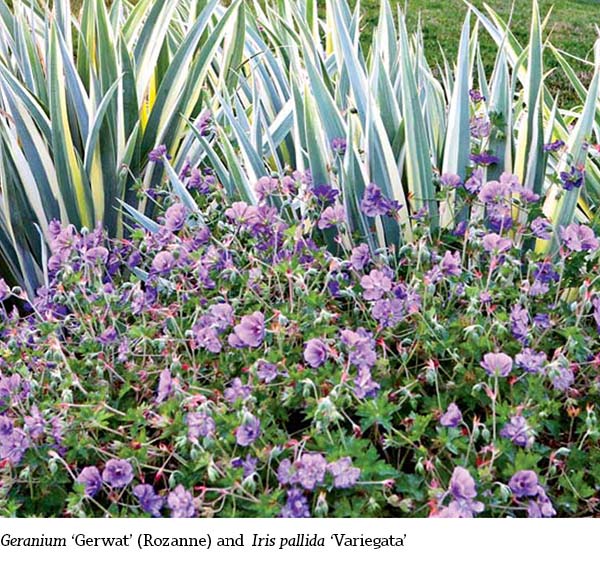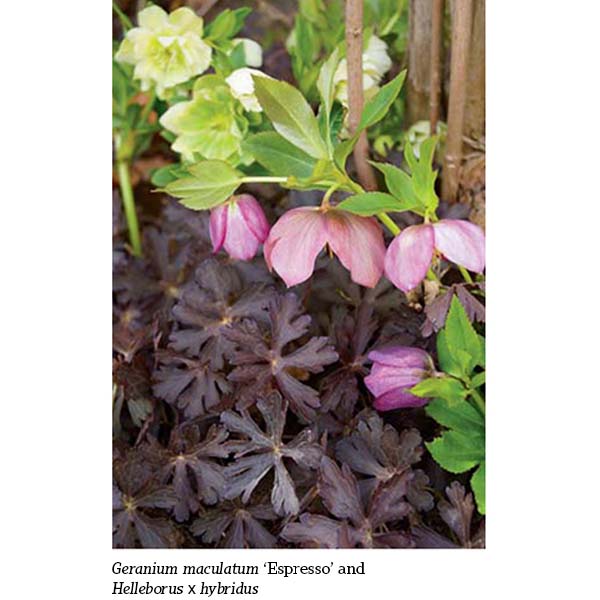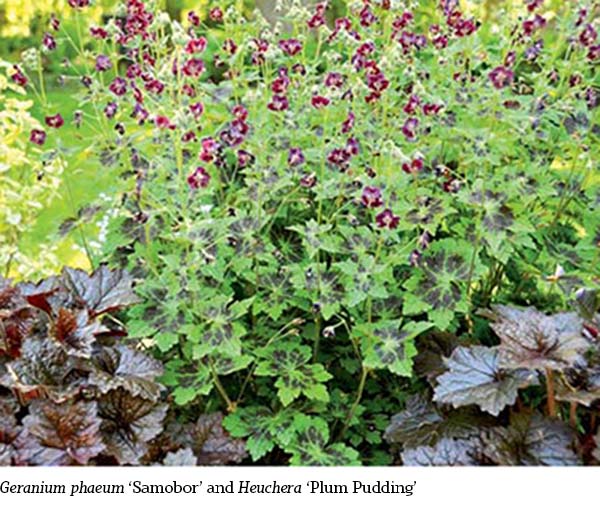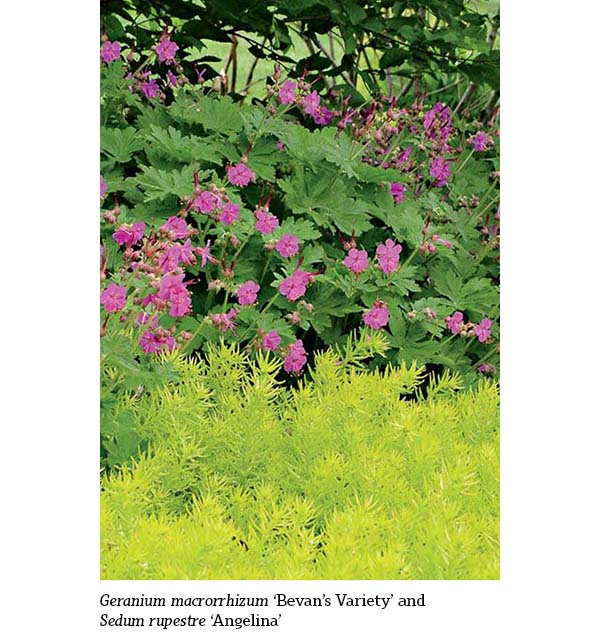
Geranium
invaluable as supporting players
Hardy geraniums
Light needs vary; average to moist but well-drained soil
Hardy geraniums (Geranium), also known as cranesbills, usually don’t play the starring role in perennial combinations, but they’re invaluable as supporting players. Two of the most readily available species for full sun (or light shade, in hot-summer gardens) include bloody cranesbill (G. sanguineum), with purplish pink, pink, or white flowers on 8- to 12-inch-tall plants, for Zones 3 to 9, and meadow geranium (G. pratense), flowering in tints and shades of purple-blue as well as white atop 1- to 2-foot-tall stems, for Zones 4 to 8.
There are many outstanding hybrids, as well. Some of the best known in the purple-blue range include Rozanne (‘Gerwat’), to about 18 inches tall, and ‘Brookside’ and ‘Johnson’s Blue’, which usually reach 18 to 24 inches tall in bloom; all three are generally hardy in Zones 3 to 8. Two among the pinks include pale ‘Biokovo’ and richer ‘Biokovo Karmina’, both selections of G. × cantabrigiense, for Zones 4 to 9: They generally reach 8 to 12 inches tall in flower. These two are quite adaptable, growing in either sun or shade and tolerating drier conditions than many other geraniums.
A couple of other hardy geraniums that can grow in either sun or shade in Zones 3 to 8 include wild geranium (G. maculatum), with pink or white flowers on 1- to 2-foot-tall stems, and bigroot geranium (G. macrorrhizum), in shades of pink or white on stems to about 1 foot tall.
Color Considerations
If you’re drawn to combinations based on soft colors, use the delicately hued hardy geranium cultivars to complement pastel yellow, pink, peach, light purple, and lavender blue flowers, as well as gray or blue leaves. The purple-blue hardy geraniums are also valuable additions to a blue-themed bed or border with blue false indigo (Baptisia australis), catmints (Nepeta), columbines (Aquilegia), irises, and perennial salvias (Salvia), to name just a few possible partners.
The magenta, vivid pink, and richer purple-blue geraniums can hold their own with other perennials in those hues, as well as with yellow flowers and foliage, in bright-colored combinations. They’re also excellent for adding a bit of “wow” to primarily pastel borders.
Along with their overall petal hue, quite a few hardy geraniums have at least one other color in their flowers—a white or dark center, for instance, or dark veining. These markings are subtle because the flowers are rather small, but they’re worth considering when choosing companions for plantings you’ll see at close range. Hybrid ‘Patricia’, for instance, produces magenta pink flowers that have near-black centers, which look great near a dark-leaved partner, such as ‘Obsidian’ heuchera (Heuchera).
Some hardy geraniums contribute color to perennial combos even when not in bloom, thanks to showy foliage. ‘Samobor’ mourning widow (G. phaeum), for instance, has deep purple markings on its green leaves (matching deep purple flowers, too). ‘Elizabeth Ann’ and ‘Espresso’ wild geranium (G. maculatum) have deep purple new leaves that age to chocolate brown; plants sold as ‘Dark Reiter’ and ‘Midnight Reiter’ meadow geranium (G. pratense) have superdark young foliage that turns purplish green in summer. There are several selections with yellow foliage, as well, such as the magenta-flowered hybrid ‘Ann Folkard’, which can look spectacular weaving up through dark-leaved shrubs. Leaf markings and colors tend to be brightest in spring to early summer, making them great matches for early bulbs and a wide range of flowering and foliage partners.
A Perfect Match
Tired of ‘Brookside’ hardy geranium sprawling just as it reached peak bloom each June, I finally moved it near the middle of a border to fill an empty spot in between a Golden Spirit smokebush (Cotinus coggygria ‘Ancot’) and a clump of ‘Screamin’ Yellow’ yellow false indigo (Baptisia sphaerocarpa). The following year, ‘Brookside’ wove itself up through its taller companions to make a brilliant blue-purple and yellow combo.
Shapes and Textures
The short hardy geraniums, such as bloody cranesbill and ‘Biokovo’, have a low-spreading form and work well around upright companions. Hardy geraniums that have a more upright, mounded shape or a loosely clumping form look best a foot or two back from the edge of a bed or border, where they can mingle with their companions and be less likely to sprawl. Rozanne, in particular, looks great weaving up through other perennials, roses, and other shrubs. Hardy geraniums are also excellent partners for alliums (Allium) and lilies (Lilium), complementing the flowers of those bulbs while covering up the uninteresting lower stems.
Shallowly to deeply lobed leaves and relatively small, saucer- to bowl-shaped blooms give hardy geraniums an overall medium to fine texture. They benefit from companions with more distinctive habits and leaf shapes, such as strongly upright plants or companions that have broad leaves (like those of hostas) or spiky foliage (irises, for example). They make charming partners for larger blooms, such as those of peonies; daisy-form perennials, such as marguerites (Anthemis); spiky blossoms, like those of perennial salvias (Salvia); and clustered flowers, like those of yarrows (Achillea).
Seasonal Features
Peak bloom time for most hardy geraniums is late spring and early summer (starting a couple of weeks earlier in warmer zones and later in cooler regions), though they may continue to produce scattered new blooms through the rest of summer. As autumn approaches, the leaves of some geraniums, such as ‘Biokovo’, bloody cranesbill, and ‘Brookside’, can turn showy shades of red and orange. In sheltered spots—particularly in mild areas—bigroot geranium and its hybrids may stay evergreen for part or all of winter.
Special Effects
Hardy geraniums fit into beds and borders of all sizes and into some specialized areas, as well.
Groundcover combos. With their low-spreading habit and tolerance of dry shade, bigroot geranium and G. × cantabrigiense make easy-care groundcovers around shrubs. Pair them with other tough perennials that can tolerate similar conditions, such as bergenias (Bergenia) and epimediums (Epimedium).
Woodland gardens. Wild geranium looks right at home in a woodland garden with other shade-tolerant natives such as creeping Jacob’s ladder (Polemonium reptans), foamflowers (Tiarella), and fringed bleeding heart (Dicentra eximia).
A Trim in Time
If your hardy geraniums stop flowering, start crowding their companions, or simply look tired or untidy at some point during summer, a quick clip can work wonders.
On the low, spreading types, such as bloody cranesbill (Geranium sanguineum) and bigroot geranium (G. macrorrhizum), trim lightly to remove the seed heads or finished flowering stems. Upright and trailing types can benefit from a harder cut. If new leaves are already coming up in the middle of the plant, trim the leggy old stems back to that fresh growth; otherwise, cut all the top growth back to about 1 inch above the ground. Within a few weeks, you’ll be enjoying the fresh foliage and maybe even more flowers for late summer and fall.
Bloom Buddies
Marvelous Matches for Flowering Combos
Flowering mainly in late spring and early summer, hardy geraniums (Geranium) coincide or overlap with the bloom periods of many popular perennials. Here are some possible companions that also thrive in sun to light shade and average to moist but well-drained soil.
Ajugas (Ajuga)
Baptisias (Baptisia)
Bearded iris (Iris Bearded Hybrids)
Bellflowers (Campanula)
Bluestars (Amsonia)
Carolina phlox (Phlox carolina)
Columbines (Aquilegia)
Coreopsis (Coreopsis)
Dianthus (Dianthus)
Foxgloves (Digitalis)
Lady’s mantle (Alchemilla mollis)
Lemon lily (Hemerocallis lilioasphodelus)
Meadow phlox (Phlox maculata)
Meadow rues (Thalictrum)
Perennial salvias (Salvia)
Pincushion flowers (Scabiosa)
Red valerian (Centranthus ruber)
Rose campion (Lychnis coronaria)
Siberian iris (Iris sibirica)
Veronicas (Veronica)
Yarrows (Achillea)




